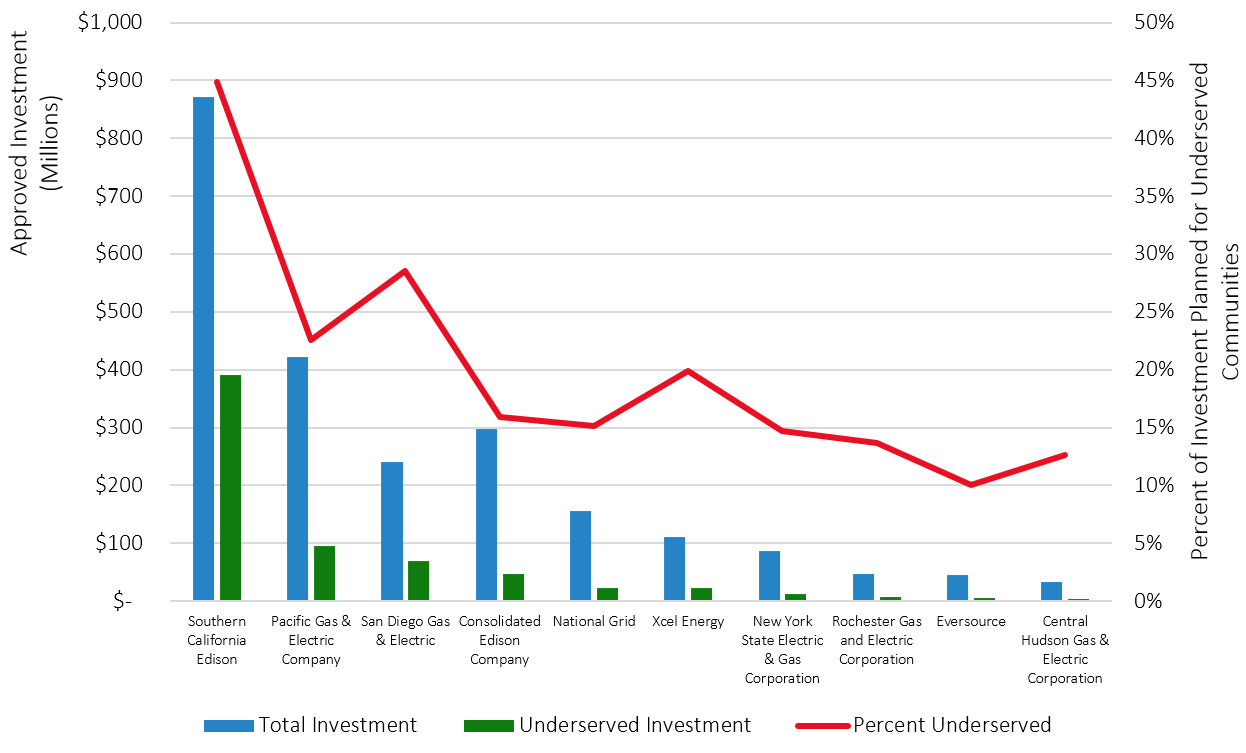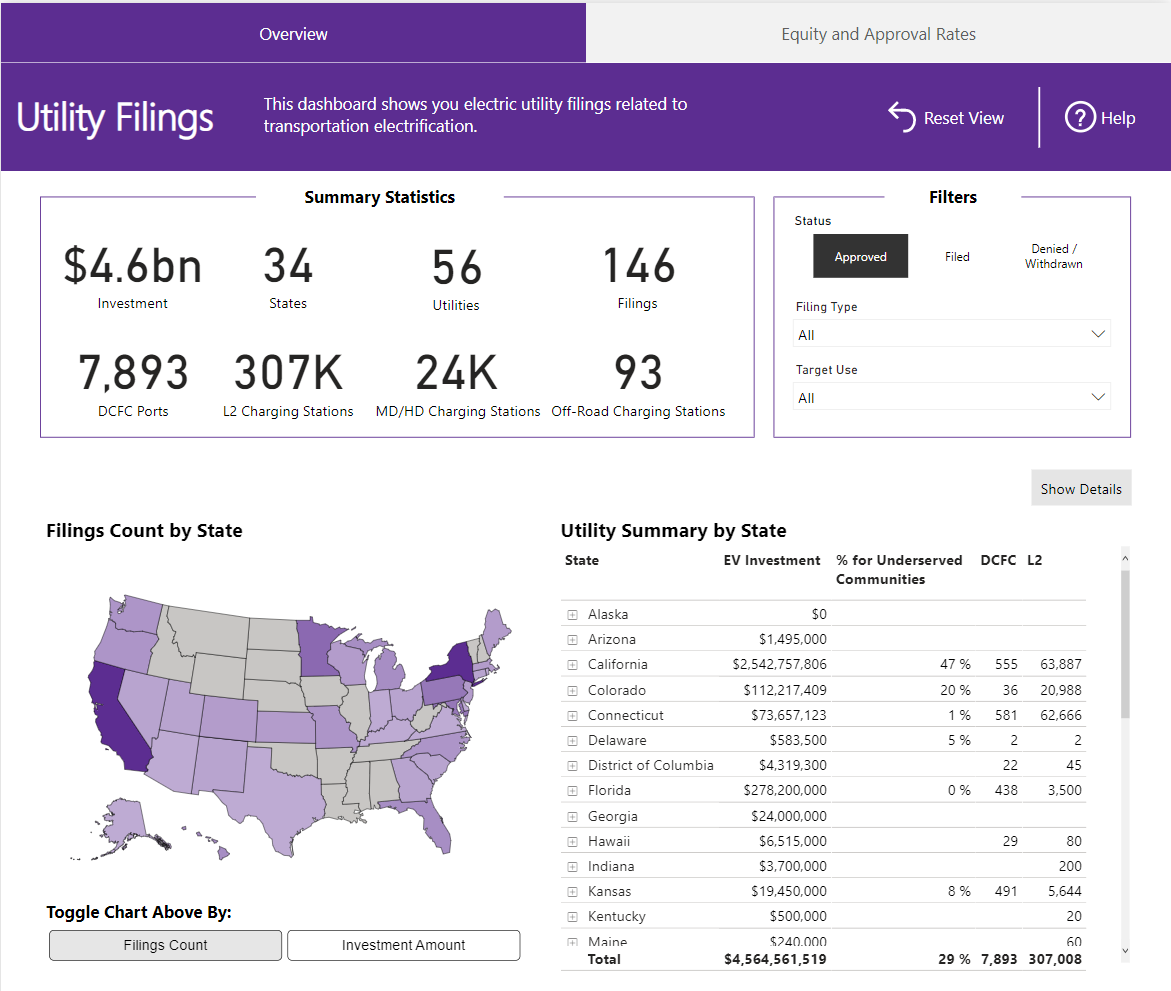Figure 1: Planned investment in underserved communities by investor-owned utilities (Top 10)
Source: EV Hub
In the first half of 2021, electric utilities were approved to invest more than $44 million in underserved communities led by filings from San Diego Gas and Electric and Xcel Energy Colorado. New investment this year brings the total electric utility investment planned for underserved communities tracked on EV Hub to $770 million.
Xcel Energy’s comprehensive transportation electrification plan dedicates $22 million of investment to underserved communities and San Diego Gas & Electric’s make-ready extension adds $21.8 million. A small filing from Tampa Electric in Florida contributes $275,000 of planned investment in underserved communities, rounding out the $44 million of dedicated investment in underserved communities approved so far in 2021. Pending filings in New Mexico, Michigan, and Pennsylvania could add an additional $4 million of investment in underserved communities if they are approved. Beyond dedicated investment, an approved filing from Atlantic City Electric worth $20 million contains equity goals but does not allocate a specified percentage to underserved communities. Specifically, the program includes a multi-family dwelling rebate program that offers higher rebates for multi-family dwellings in underserved communities.
State legislators continue to play an important role driving investment in underserved communities. Nearly the entire $44 million approved so far in 2021 comes from California or Colorado where legislators have enacted laws that require utilities to prioritize equity in transportation electrification. Colorado’s Senate Bill 19-077, passed May 2019, directed utilities to prioritize equitable access when developing their transportation electrification plans. In fact, in its recently approved $110 million program, Xcel initially proposed allocating 15 percent of the investment to equity focused programs, but the Colorado Public Utilities Commission’s final order pushed Xcel to exceed this number, citing the mandate from Senate Bill 19-077. Specifically, the Commission maintained the program-wide floor of 15 percent but ordered Xcel to raise the minimum percentage for the Research, Innovation, Partnerships element to 30 percent and to add a $5 million equity rebate. California’s AB 841 goes a step further by requiring a minimum of 35 percent of investment pursuant to transportation electrification plans to be located in underserved communities. In total, California represents over 80 percent of dedicated funding for underserved communities.
This update is the third in a series of data stories focused on equity investments in electric utility filings. The first data story was published in December 2019 followed by an update in December 2020. The series is published with the support of the Natural Resources Defense Council (NRDC). To track these equity elements, we used the Greenlining Institute’s Mobility Equity Framework as a guide and developed several indicators to classify and track the equity commitments of different utility transportation electrification programs. A program is considered equitable to varying degrees if it aims to ensure that underserved communities benefit from a program. In addition to assessing the amount of investment committed to underserved communities, we also look to Greenlining’s focus on community empowerment. We track equity goals, requirements to invest a certain amount of funds in underserved communities, labor requirements, public reporting requirements, and engagement with underserved communities.
To date, 62 out of the 143 filings tracked on the EV Hub include an equity goal in at least one element of the program. Equity elements are more common in 2021 than they have been in previous years with half of the 12 filings approved so far including at least one element that prioritizes investment in underserved communities. A deeper look at investment pledged directly to these groups reveals that among programs that include at least one element that prioritize investment in underserved communities, over 30 percent of the total approved investment is designated for underserved communities. This represents a decrease of six percentage points from the last data story we released on December 21, 2020. Table 1 summarizes total program investment and investment planned for underserved communities in each approved program based on information available through June 2021.
Table 1: Approved Utility Programs including a Transportation Equity Element through June 2021
|
Utility |
State |
Total Investment |
Investment Planned for Underserved Communities |
|
Southern California Edison |
California |
$872 M |
$391 M |
|
Pacific Gas & Electric Company |
California |
$421 M |
$95 M |
|
San Diego Gas & Electric [1] |
California |
$240 M |
$69 M |
|
Consolidated Edison Company |
New York |
$297 M |
$47 M |
|
National Grid |
New York |
$155 M |
$23 M |
|
Xcel Energy |
Colorado |
$110 M |
$22 M |
|
New York State Electric & Gas Corporation |
New York |
$87 M |
$13 M |
|
New York State Energy and Research Development Authority (NYSERDA) Environmental Justice Grants [2] |
New York |
$85 M |
$85 M |
|
Rochester Gas and Electric Corporation |
New York |
$48 M |
$6.5 M |
|
Eversource |
Massachusetts |
$45 M |
$4.5 M |
|
Central Hudson Gas & Electric Corporation |
New York |
$33 M |
$4.2 M |
|
Orange and Rockland Utilities |
New York |
$28 M |
$3.9 M |
|
Portland General Electric |
Oregon |
$13 M |
$2.7 M |
|
Duke Energy |
Florida |
$8 M |
$760,000 |
|
Potomac Edison |
Maryland |
$6.9 M |
$461,000 |
|
Puget Sound Energy |
Washington |
$19 M |
$425,000 |
|
Ameren Missouri |
Missouri |
$11 M |
$400,000 |
|
AEP Ohio |
Ohio |
$10 M |
$370,000 |
|
Tampa Electric |
Florida |
$2.3 M |
$275,000 |
|
National Grid |
Massachusetts |
$22 M |
$207,000 |
|
Duquesne Light Company |
Pennsylvania |
$2.6 M |
$180,000 |
|
Liberty Utilities |
California |
$6.6 M |
$160,000 |
|
Delmarva Power |
Delaware |
$580,000 |
$30,000 |
|
Total |
$2.52 B |
$770 M |
This table summarizes approved utility investment planned for underserved communities through June 2021. California leads with more than 80 percent of the total planned investment in underserved communities. These investment figures were collected based on information from individual utility filing documents.
Source: EV Hub Utility Filing Dashboard
With the January 2021 approval of its Colorado transportation electrification plan, Xcel Energy rises to sixth out of all utilities with funds allocated to underserved communities. With the higher equity targets ordered by the Commission in Xcel’s approved $110 million program, Xcel’s transportation electrification plan is expected to bring at least $21.9 million of investment to underserved communities, representing almost 20 percent of the total program budget. Equity-focused elements of the final plan include higher vehicle and charging station rebates for income-qualified customers, support for electric public transportation and ride sharing, and community charging hubs in income-qualified and higher-emissions communities.
On April 19, 2021, SDG&E was approved to invest in an extension and modification of the Power Your Drive program worth $43.5 million. The decision set a 50 percent underserved community investment target, exceeding the statutory requirement of 35 percent set by AB 841. Under the plan, SDG&E will install and own the make-ready charging infrastructure as well as the charging ports at multifamily dwellings located in disadvantaged communities [3]. Outside of disadvantaged communities, SDG&E will install and own the make-ready portion of charging infrastructure at workplaces and multifamily dwellings, but customer’s will be responsible for the cost of the chargers.
Several pending transportation electrification programs also include dedicated funding for underserved communities. Public Service Company of New Mexico’s transportation electrification plan filed in December 2020 sets aside nearly a quarter of the total investment for underserved communities. The plan includes rebates for residential charging stations and make-ready support for charging for multi-unit dwellings (MUDs), transit buses, public stations, and workplaces. At least $2 million of the $8.4 million program is dedicated to underserved communities. In Michigan, Consumers Energy filed a proposed extension of their PowerMIFleet program that requests $1.6 million in additional funds to expand the program to support underserved communities. Finally, on April 16, 2021, Duquesne Light Company in Pennsylvania proposed a transportation electrification plan worth $4.3 million that includes a target for 25 percent of projects serve or are located in underserved communities. The filing sets bonus financial incentives and percentage targets for deployments in environmental justice communities and allocates at least $586,000 of the $4.3 million program to be invested in underserved communities.
Importantly, Table 1 only includes programs that carve out all or a certain percentage of investment for underserved communities. This excludes programs with less concrete goals that indicate a prioritization of underserved communities in the rollout of the program. In addition, there are other important ways that utilities can prioritize underserved communities, such as including equity in siting criteria or targeting certain use cases, such as multi-family homes or public transit, that are expected to serve underserved communities. In addition, medium- and heavy-duty (MDHD) vehicle electrification programs are extremely important in order to improve air quality and health in underserved communities, since dangerous criteria air pollutants from MDHD vehicles have historically been disproportionately concentrated in underserved communities, which are often located closer to sources like ports and highways. This year has seen at least two filings prioritize equity in ways other than through investment carve-outs. These programs are described below.
On March 30, 2021, PECO Energy Company filed a program proposing $1 million to assist public transit agencies in Pennsylvania with the installation of high-capacity electric vehicle charging equipment and provide $500,000 in incentives for Level two charging stations for commercial and industrial customers. The incentive program would provide incentives of $3,000 per unit for stations in Pennsylvania Environmental Justice areas and $2,000 per unit for all other stations.
On April 1, 2021, Arizona’s two investor-owned utilities filed the second phase of their transportation electrification plan. The plan calls for significant engagement with the state’s stakeholder community with a particular focus on stakeholders from underserved communities. It also includes specific goals to increase medium- and heavy-duty EV deployment in underserved communities.
Ensuring the benefits of electric vehicles are distributed equitably will be essential as the transition to electric transportation continues to accelerate and advocacy from coalitions of environmental justice and community groups, environmental groups, and associations continue to encourage electric utilities to step up their commitments to underserved communities. Atlas will continue to track investor-owned utilities’ commitments to equity on the EV Hub Utility Filings Dashboard.
[1] This data story reports lower investment numbers for SDG&E than previous data stories due to modifications to how some of the investment are tracked in EV Hub. Notably, the Residential Charging Incentive program that SDG&E proposed in docket A1701020 was originally tracked in EV Hub as approved, based on a May 31, 2018 press release from the CPUC, which stated that the program would be approved. However, in February 2019, SDG&E withdrew the program.
[2] These programs are funded through electric ratepayer revenue, however, NYSERDA rather than the utilities is responsible for using the funds and implementing the EJ Grant programs. These programs are detailed in the July 16, 2020 New York Public Service Commission Order in Case 18-E-0138.
[3] Disadvantaged communities refers to the top 25 percent of census tracts throughout California which most suffer from a combination of economic, health, and environmental burdens as determined by the CalEnviroScreen tool.
Learn More







